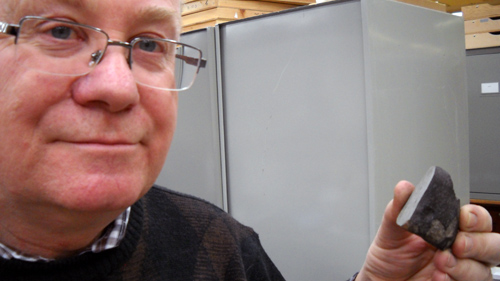
Iain Campbell wanted a few Mars rocks to study, but where on Earth could he find them? A handful turned out to be nearer than he’d thought.
Toronto’s Royal Ontario Museum (ROM) isn’t exactly on the Guelph physicist’s doorstep. But it’s a lot closer than the red planet itself. Now Campbell hopes to examine several Martian meteorites from the museum’s geology collection as an adjunct project to what he calls “the biggest single research venture in the University of Guelph’s history.”
This past summer saw the latest NASA robotic rover land on Mars. Dubbed Curiosity, the rover is hunting for evidence that our interplanetary neighbour might have supported life.
One of its key instruments – an alpha particle X-ray spectrometer (APXS) – will probe Martian soil and rock. The device was built by an international research team led by Guelph physics professor Ralf Gellert; he and other U of G members are now monitoring APXS results in a specially equipped operations centre on campus.
Campbell says studying ROM meteorites will help in interpreting what the rover finds or even in predicting what its instrument might turn up on Curiosity’s planned two-year expedition.
He’s applied for funding to renovate existing equipment at Guelph. Filling much of his MacNaughton basement lab, that proton microprobe bears little resemblance to the coffee cup-sized APXS on the rover’s arm.
The former device fires beams of protons at varied samples. On Mars, the APXS aims X-rays and alpha particles at rocks and soil. Despite their differences, the purpose is the same: to analyze what elements exist – and how much of each – in a sample.
All going well, by next year Campbell will obtain samples of those ROM rocks for analysis.
“It’s important to learn what these Mars samples are made of,” says physics post-doc Irina Pradler. After studying experimental particle physics in Russia and Germany, she joined the Guelph APXS team in 2011.
ROM scientists have already studied their rock collection with various instruments, but not with a proton microprobe, says Kim Tait, the museum’s curator of mineralogy.
The museum holds about 15 Martian meteorites among its collection of “space rocks.” Scientists believe they were ejected from Mars in what Tait calls “cosmic bumper cars” involving collisions with comets or asteroids.
“These are pieces of the planet that have come to us,” she says.
Scientists think early Mars and Earth looked more alike but followed different paths.
Referring to the red planet, Tait says, “This is a snapshot of what could have happened to our planet under different conditions.”
The museum’s Mars rocks are among hundreds of meteorites donated by Dr. David Gregory, a family physician and amateur rock hound in St. Thomas, Ont.
A reformed fossil-hunter, he has collected meteorites for about 15 years through Moroccan contacts. Most meteorites are found in the world’s deserts – including Antarctica – where they are easier to spot against sand or ice.
“I was always interested in space,” says Gregory, who remembers seeing the ROM’s meteorites during visits in elementary school.
This past August, he was awake past midnight to watch the online feed of the Curiosity landing. “I was on the edge of my chair. Looking back, it was like Henderson scoring the goal in the 1972 Canada-versus-Russia hockey series, but better.”
The Mars rover and other unmanned expeditions to other parts of the solar system will help prepare us for interplanetary travel, says Gregory. “We need to know where we’re going next.”